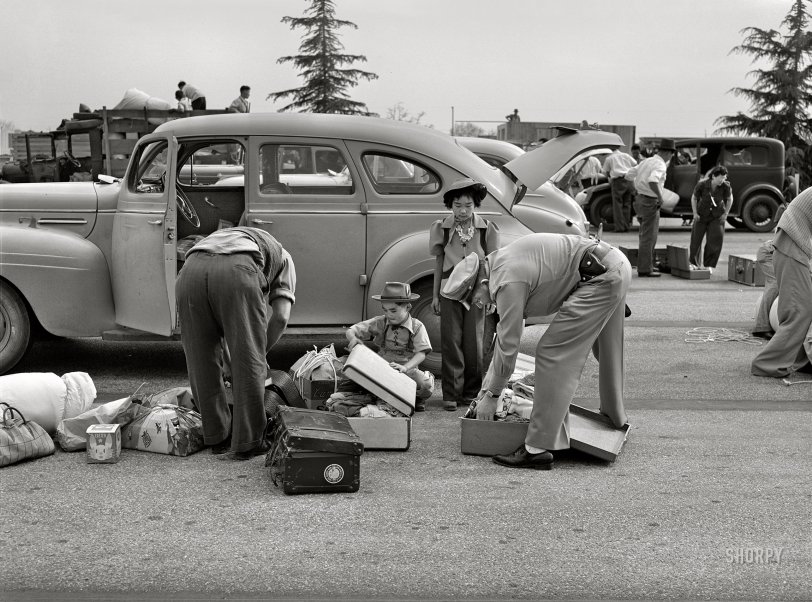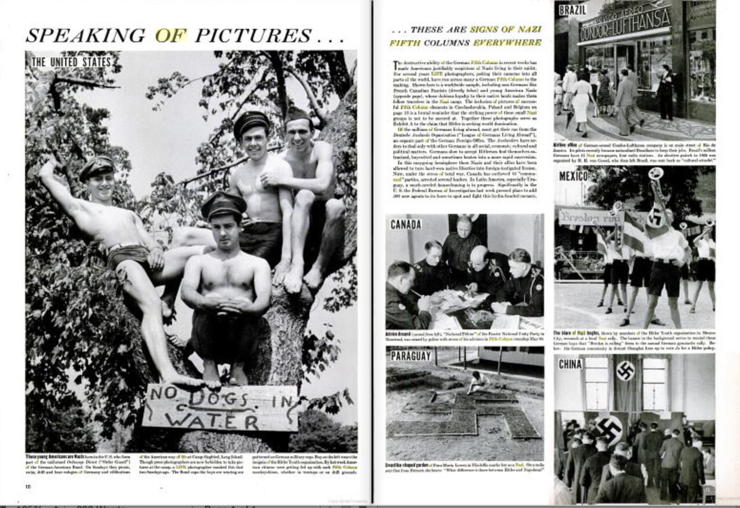


Framed or unframed, desk size to sofa size, printed by us in Arizona and Alabama since 2007. Explore now.
Shorpy is funded by you. Patreon contributors get an ad-free experience.
Learn more.

- Lofty addition
- In 1912
- Keenan Building
- Six years old
- Taken from the P.J. McArdle Roadway?
- It stood only 47 years
- Three track mind
- Incline to the right
- Reach for the sky, 1912 style
- No clean sweep
- Same Job Title, Same Face
- Sadly Lost
- Beautiful ...
- Where you get your kicks
- Aim High
- Pueblo Revival sisters
- Pueblo Neoclassicism
- Milk Man
- Regional dialect.
- Spielberg's inspiration
- Great Photo
- Loaf Story
- Do you still have the Rakes category?
- Could almost be a scene from the 1957 movie 'Hell Drivers'
- The Wages of Fear.
- Conspicuous by their absence
- Got Milk?
- All that aluminum
- No lefties
- Smoke 'em if you've got 'em
Print Emporium
Santa Anita: 1942

April 1942. "Santa Anita reception center, Los Angeles County, California. The evacuation of Japanese and Japanese-Americans from West Coast areas under United States Army war emergency order. Examining baggage of Japanese as they arrive at the center." Acetate negative by Russell Lee for the Office of War Information. View full size.
The German Side of This
My maternal grandparents were German-born residents of NYC at the time of WWII. In researching the family tree a decade ago, when the 1940 census data was released, I discovered just how fearful they were of this happening to them.
The block they lived on at the time was nearly all single-lot houses, but there was - and still is - a sole double-lot house, thus creating a gap in the house numbers. My grandparents used that house number, listed their daughter as a son and made them younger, and changed several other details. My suspicion is that they had a plan of "escape" for lack of a better term, the false data being intended to give them a hoped for hair's breadth of a chance to slip away and get to nearby relatives.
My aunt was an American by birth, my grandfather became an American citizen - though I am blanking on whether it was before or after WWII, but my grandmother never became a US citizen and her greencard still resides in her purse nearly 40 years after her death. I suspect that they were scared of deportation to Germany prior to the US entering the war in December of 1941. The only thing my mother and I know for certain was that their 1930s habits of social gatherings ceased after the US Nazi Party started drumming up support at these events and that brought in intense government attention. It became unhealthy to be seen as German - an attitude that, unfortunately, was still a problem for me as a kid in the late 1970s.
Opinions matter
Well, one could argue it was a different time and a different world and in war there are no winners only survivors.
The U.S. was not alone
Canada was in on this macabre scheme also, nothing to be proud of, only lately is it trying to make apologies.
Shame on us.
Understanding history requires being able to understand the world as it existed at the time. That said, I agree with the previous post. This was nothing more than unveiled racism. One could argue (and I'm sure someone did), that we were better than the Germans who also placed a race of people in internment camps, but looking back on it now, all I feel is shame that we dishonored these people in this way.
Fifth columns everywhere
American fear of ethnic populations preceded Pearl Harbor and initially focused on Germans. After the fall of France in May-June 1940, the French government adopted a self-serving argument that the humiliating defeat was due not to the French military but to pro-German "fifth columnists."
American publications picked up the theme, pushing fear of German agents in the homeland. 'Life' magazine's June 1940 feature was followed by 'Time' calling fifth columns a "national phenomenon." So when Pearl Harbor occurred months later, the paranoid atmosphere was already in place and the focus quickly shifted to the Japanese.
Nevertheless, at least 11,000 ethnic Germans were "detained" by the U.S. government during World War II. But Germans were examined on an individual basis, whereas Japanese were interned en masse simply because of their ethnicity and their location on the West coast.

You cannot put lipstick on this pig
In 2021 a commentor defended the mass incarceration of Japanese Americans while defending not mass incarcerating German or Italian Americans. The commentor said German Americans were mostly in the upper Midwest, so not a threat. Of course, this ignores the large German American population in the NYC boroughs. They acknowledged Italian Americans were concentrated in the Northeast, but were not considered to be a military threat, for some, undisclosed reason. How convenient.
The most telling sentence was, "Japanese were not assimilated into American culture to the degree that Germans and Italians were and so were looked at with much more suspicion." I would very much like to know what the litmus test is for being properly assimilated into the American culture. The Northeast was and still is filled with Italian and German American clubs, where both your parents have to have direct lineage to the old country and where the old country tongue is usually spoken. I bet both kids in this photo could recite the Pledge of Allegiance and knew the words to the National Anthem (few of us can actually sing that song).
This was racism.
























On Shorpy:
Today’s Top 5